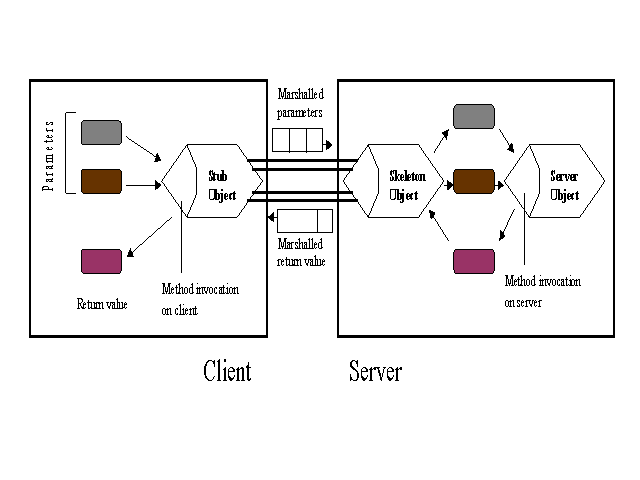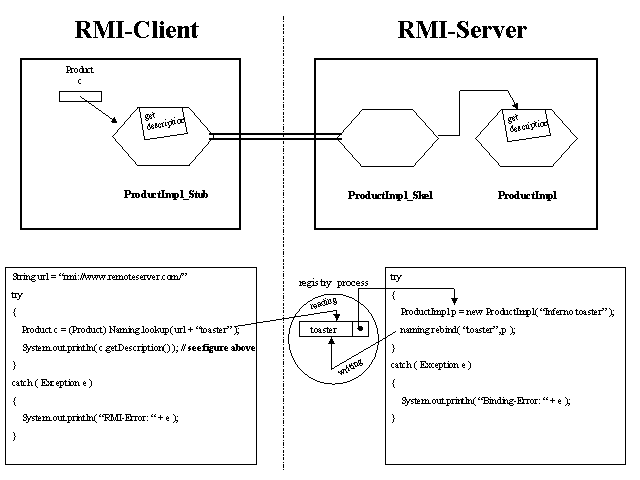RMI is a mechanism for communicating (only) between two machines running
Java Virtual Machines.When Java code on machine A needs a
service or a method, respectively, of (remote Java object) objB
on machine B it starts a remote method invocation. It does this
the same way as invoking a local (Java) object's method.The whole communication
behind the remote invocation is done by the RMI mechanism.
When referencing a remote object residing on machine B from code being on machine A there are always two intermediate objects actually handling the communication: a stub object and a skeleton object. When a remote method invocation comes up the following tasks are handled by these two objects (see also figure):
The stub object (on machine A) has to
- build an information block thats consists of
- an identifier of the remote object to be used,
- an operation number describing the method to be called and
- the marshalled parameters (method parameters have to be encoded into a format suitable for transporting them across the net)
- send this information to the server
- to unmarshal the parameters,
- to call the desired method on the real object lying on the server,
- to capture the return value or exception of the call on the server,
- to marshal this value,
- to send a package consisting of the value in the marshalled form back to the stub on the client, machine A.

To get a better feeling how to deal with RMI, let's give a little example:
Let's assume there is a remote object belonging to the class Product offering the method getDescription(), whose return value is a String object. Let's further assume this method is invoked by a remote machine (not very surprising). The following figure shows what is going on in order to handle this situation, on client side as well as on server side.

Three processes are involved in the RMI scenario described above. The registry process has to be started at first. It observes a specific port for bindings between logical names and real objects (the same port also serves lookups). Afterwards the server process is started on the same machine. It gives the binding information to the registry process by sending them to the corresponding port. Then everything has be done on server side. Now any client process can be started. It will send lookups to the port of the registry process. Now a connection via a stub object and a skeleton object becomes established. Concerning a detailled description of this process I recommend following the bibliographical links.
- For any remote object (getting a reference on client side) there is one stub object (on each client side) and one skeleton object (on server side). These objects are created automatically; however the corresponding classes (in our example ProductImpl_Stub.class and ProductImpl_Skel.class) must have been created (by the rmic command) and must be available, respectively.
- Parameters of remote method invocations:
- Remote objects are passed back as stubs.
- Non-remote objects are copied and get serialized (so they have to implement the interface Serializable)
In order to get a deeper insight in the RMI stuff I recommend to have
a look at
- Cay S. Horstmann and Gary Cornell, core JAVA 1.1, Volume II - Advanced Features, The Sunsoft Press, 1998, pp.224-263.
- (SUN's) Remote Method Invocation Specification